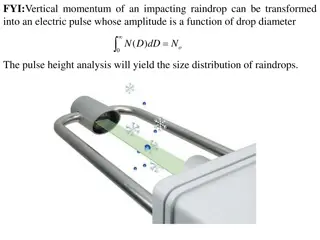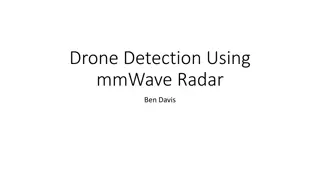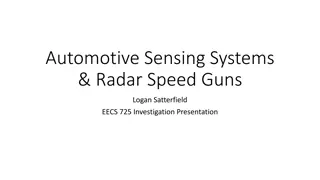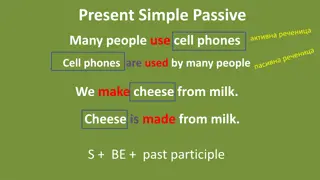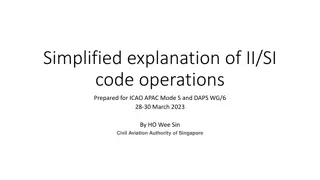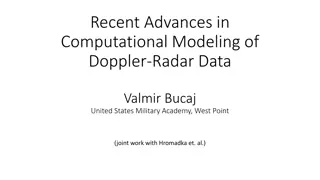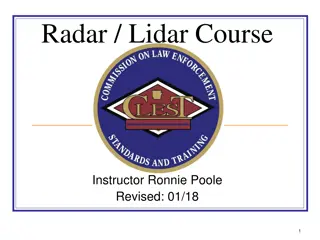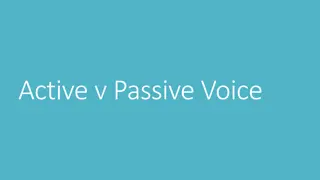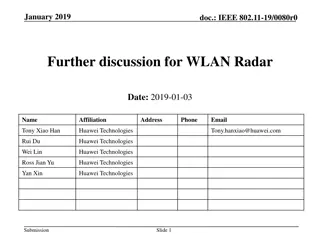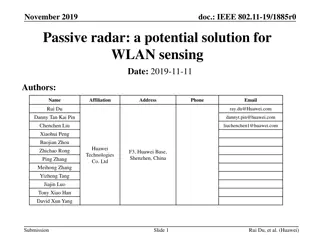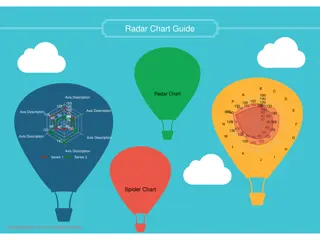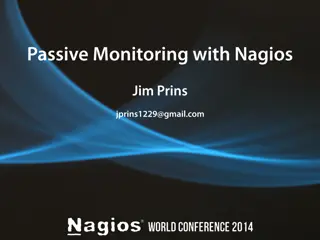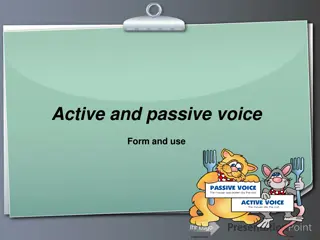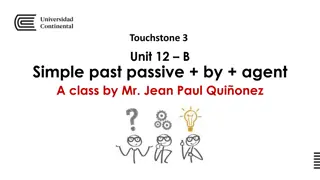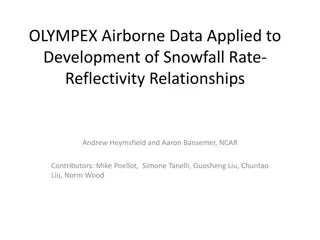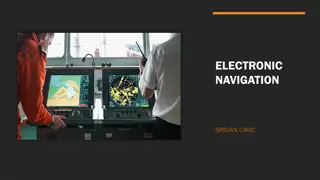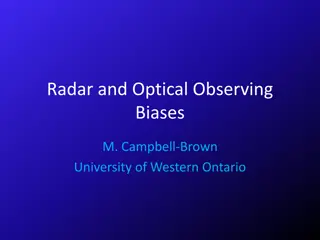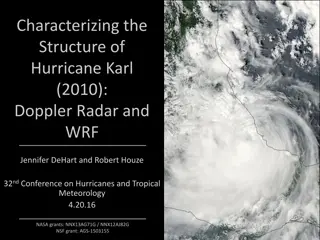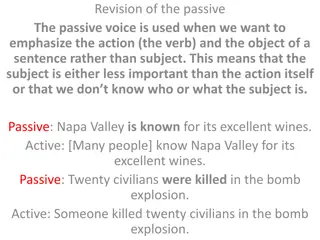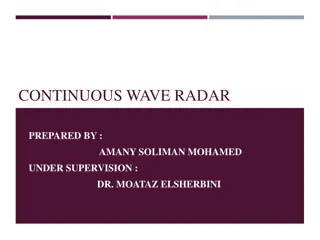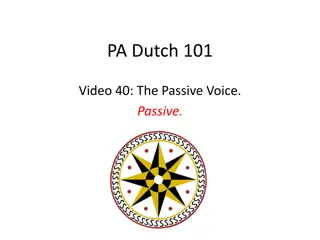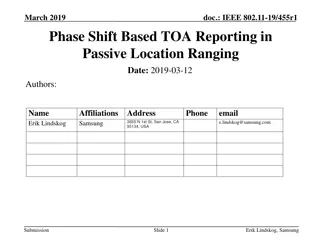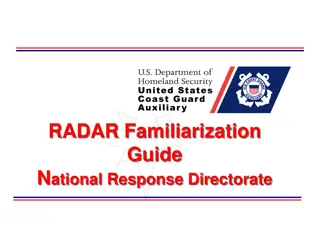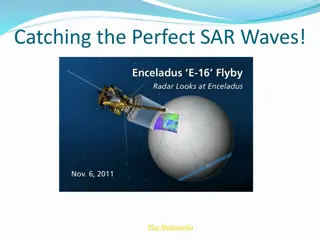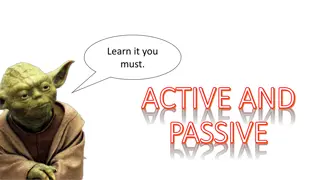Passive verb forms
Passive verb forms involve using "be" in a specific tense along with the past participle of a main verb to change the object of an active sentence into the subject of a passive sentence. The passive voice is commonly used in formal writing when the doer of the action is unknown, obvious, or purposel
3 views • 13 slides
Advancing Radar Science: Open-Source Collaboration for Precipitation Estimation
Explore the innovative work presented at the Open Radar Science in SAIL conference featuring collaborative research, open-source tools like Py-ART and Xradar, and value-added products enhancing quantitative precipitation estimates. Learn about CMAC, SQUIRE, and other techniques for radar data proces
2 views • 10 slides
Insights into Raindrop Size Distribution and Precipitation Intensity through Radar Technology
Vertical momentum of impacting raindrops can be converted into an electric pulse to analyze raindrop size distribution. Disdrometers using video cameras can directly count raindrops for sizing. Radar technology provides superior data on precipitation accumulation and intensity by measuring radar ref
4 views • 9 slides
BTH/OTH Radar and Maritime Surveillance Radar Overview
The article discusses BTH/OTH radar systems and maritime surveillance radars, exploring their functionalities, benefits, drawbacks, and real-world examples. It delves into the working principles of OTH radar, showcasing how it operates through the ionosphere. Additionally, it covers the concept of m
5 views • 12 slides
Active and Passive Voice Usage
Learn about the differences between active and passive voice in English grammar, how to convert sentences from active to passive voice, and examples of active and passive voice usage in different tenses. Understand which verbs can be used in passive voice constructions and practice changing sentence
9 views • 7 slides
Drone Detection Using mmWave Radar for Effective Surveillance
Utilizing mmWave radar technology for drone detection offers solutions to concerns such as surveillance, drug smuggling, hostile intent, and invasion of privacy. The compact and cost-effective mmWave radar systems enable efficient detection and classification of drones, including those with minimal
0 views • 8 slides
Automotive Sensing Systems & Radar Technology Overview
Explore the world of automotive sensing systems and radar technology including radar speed guns. Learn about the sensors used in cars for various applications such as radar cruise control, collision detection, and more. Discover the characteristics of these sensors and how they can be augmented or r
0 views • 7 slides
Learning Passive Voice in Present Simple Tense: Exercises and Examples
Explore the passive voice in present simple tense through examples and exercises. Understand how to form passive sentences with regular and irregular verbs. Practice converting active sentences into passive voice for a deeper grasp of English grammar concepts.
2 views • 8 slides
Passive Voice in English Grammar
Explore the concept of passive voice in English grammar through examples and explanations. Learn how to identify passive voice, transform active voice sentences into passive voice, and understand the importance of focusing on the action rather than the doer. Discover the structure of passive voice s
3 views • 7 slides
Mode-S Radar Operations and Identifiers
This simplified explanation delves into the fundamental principles of radar operations, focusing on Primary and Secondary radar systems, including Mode A/C and Mode S functionalities. It covers radar interrogation, replies, and the significance of radar identifiers (II and SI codes) in managing over
0 views • 19 slides
Recent Advances in Computational Doppler Radar Data Modeling
Explore the latest developments in computational modeling of Doppler radar data, focusing on error estimation, dual vs. single pol radars comparison, uncertainty quantification, and methodology for analyzing Doppler radar predictions against gauge measurements. The study involves data from multiple
0 views • 40 slides
Mastering Writing Skills & Passive Voice: Lesson Review
Learn how to identify sequencing phrases, read for specific information, describe a process using passive voice, and write process descriptions. Also, understand the structure of passive sentences and when to use the by-agent in passive voice constructions.
2 views • 16 slides
Radar and Lidar Course Legal Requirements in Arkansas
This content provides information on the legal considerations, training requirements, and regulations for radar and lidar operators in Arkansas, as well as the criteria for CLEST certification. It covers statutes related to operator qualifications, speed trap laws, and the issuance of operator certi
1 views • 187 slides
Active vs Passive Voice in Writing
Active vs passive voice explained with examples, definition, and two ways to fix passive voice. Learn how to change passive voice sentences to active voice with practical examples provided.
8 views • 5 slides
Radar Function Integration in WLAN: January 2019 Discussion
The January 2019 document IEEE 802.11-19/0080r0 explores integrating radar functions into WLAN to enhance coexistence. The proposal outlines various options, including modified schemes and dedicated indication methods for radar operation within WLAN frameworks. It emphasizes the need for feedback on
3 views • 12 slides
Active and Passive Voice for Better Communication Skills
This content covers essential aspects of active and passive voice in communication skills. It explains the difference between the two voices, provides examples, and clarifies when to use passive voice. The importance of transitive verbs in forming passive sentences is highlighted along with intransi
3 views • 29 slides
Passive Radar for WLAN Sensing in Indoor Scenarios
Radar and CSI have been proposed as potential WLAN sensing techniques. This document focuses on passive radar at 5 GHz in indoor scenarios, discussing background, experimental results, signal processing techniques, and potential impacts on WLAN standards.
6 views • 15 slides
WLAN-Based Radars in the 60GHz Band Using IEEE 802.11-19/1854r0 Protocol
Utilizing IEEE 802.11ad/11ay devices, this presentation demonstrates how radar applications can be implemented with minimal hardware modifications, showcasing enhanced radar information accuracy through device collaboration. The advantages of the 60GHz band for short-range radar applications, such a
0 views • 14 slides
The Passive Voice and Versatile Verbs
Explore the concept of the passive voice and versatile verbs, including examples and reasons for using passive voice constructions. Learn about verb tenses, when to use passive voice for cohesion or when the agent is unknown, and how to add modifiers to the agent. Discover tips for using passive voi
0 views • 15 slides
Complete Guide to Radar Charts: Benefits, Drawbacks, and Tips
Radar charts, also known as spider charts, offer a graphical way to compare data in a web-like form, making it easy to evaluate multiple alternatives based on various criteria. While radar charts have benefits like highlighting strengths and deficiencies clearly, they also come with drawbacks such a
1 views • 12 slides
Mastering Passive Voice: Verb Forms and Usage
Delve into the intricacies of passive voice in English grammar, exploring verb forms commonly used in the passive voice such as manufacturing, publishing, and more. Learn how to construct passive sentences in Present Simple and Past Simple tenses with examples and practice exercises. Enhance your un
0 views • 6 slides
Managing Passive Host and Service Checks with Nagios Core
Learn how to enable passive host and service checks in Nagios Core via the configuration file, allowing for monitoring without actively polling the hosts and services. Understand the setup, configuration, and usage of passive checks in your monitoring system. Explore examples and best practices for
0 views • 30 slides
Active and Passive Voice
Explore the forms and uses of active and passive voice in English writing with examples and explanations. Learn how to distinguish between active and passive voice, create passive sentences using appropriate tenses, and understand when to use each voice effectively in different situations. Enhance y
0 views • 15 slides
Passive Voice in English: Usage and Examples
Passive voice is used to shift the focus from the subject to the object in a sentence. The passive construction is formed with the verb "to be" in the appropriate tense followed by the past participle of the main verb. Learn when to use passive voice, how to indicate the agent using "by," and how ad
2 views • 6 slides
OLYMPEX Airborne Data Analysis for Snowfall Rate-Reflectivity Relationships
Utilizing Citation aircraft data from OLYMPEX, this study focuses on developing relationships between snowfall (rainfall) rate and radar reflectivity across various radar bands. Comparisons are made between in-situ aircraft data and retrieval products from CloudSat, GPM, and TRMM datasets. Results i
0 views • 12 slides
Electronic Navigation Technologies
Electronic navigation technologies, such as satellite navigation, radio navigation, and radar navigation, utilize electricity-powered systems for precise positioning and tracking. Satellite navigation systems rely on signals from satellites for autonomous geo-spatial positioning, while radio navigat
0 views • 9 slides
Radar and Optical Observing Biases in Meteor Detection
Exploring radar and optical observing biases in meteor detection, this content delves into factors affecting mass detection, ionization efficiency, transverse radar effects, and more. Gain insights into how radar technology plays a crucial role in determining meteor properties and overcoming observa
1 views • 13 slides
Passive Voice in English Grammar
This content covers the concept of passive voice in English grammar, providing examples and explanations of how to form passive voice sentences. It includes information on intransitive and transitive verbs, transforming active voice to passive voice, and common passive voice structures. Visual aids
0 views • 16 slides
Analyzing Hurricane Karl (2010): Doppler Radar Insights
Detailed analysis of Hurricane Karl (2010) using Doppler radar and WRF simulations, focusing on precipitation patterns over Mexican terrain and underlying processes. Includes NASA and NOAA grants, airborne radar measurements, WRF simulations, flight tracks, and velocity distributions comparison betw
0 views • 19 slides
The Passive Voice in English Writing
The passive voice in English writing is utilized to emphasize the action and object of a sentence rather than the subject. It is helpful for shifting the focus of a sentence, especially when the subject is less important or unknown. Learn about the passive voice, verbs with two objects, passive in s
0 views • 7 slides
Mastering Passive Voice in English: Structure, Practice, and Examples
Explore the concept of passive voice in English, including why and how to use it. Learn the structure of passive sentences, with examples and step-by-step instructions. Practice making passive sentences from active ones. Understand when and why passive voice is commonly used by English speakers.
0 views • 6 slides
Continuous Wave Radar Systems Overview
This presentation discusses Continuous Wave radar systems, including types of radar such as CW and FM-CW systems, as well as advantages and disadvantages of CW radar. It covers topics like CW radar operation, receiver technologies, and the Doppler effect in CW radar. The content provides a comprehen
0 views • 10 slides
Passive Voice in Pennsylvania Dutch
Passive voice in Pennsylvania Dutch (PD) involves the subject of the sentence not performing the action but having the action done to them. PD uses forms of "waerre" and the past participle to form passive sentences. The presence of an agent in passive sentences is indicated using the dative preposi
0 views • 6 slides
Passive Location Ranging Using Phase Shift Based TOA Reporting
This document discusses the implementation of phase shift based time-of-arrival (TOA) reporting in passive location ranging within the IEEE 802.11 standard. The proposal suggests enabling this feature for passive ranging alongside existing active ranging methods, aiming to enhance accuracy and relia
0 views • 24 slides
Radar Familiarization Guide for Surface Operations: Understanding How Radar Works
This radar familiarization guide by the National Response Directorate provides important information on the proper use of radar equipment, including its basic principles, functions, and practical applications for surface operations. It emphasizes the significance of radar in ensuring safe navigation
0 views • 47 slides
Mechanism of Mineral Absorption in Plants: Active vs Passive Methods
Plants absorb minerals from the soil in the form of inorganic ions through both passive and active methods. Active mineral absorption requires metabolic energy, whereas passive absorption occurs along the concentration gradient by simple diffusion. The roots play a vital role in mineral absorption d
0 views • 14 slides
Electromagnetic Waves and Radar Systems
Dive into the world of electromagnetic waves and radar systems with detailed explanations on wave basics, the electromagnetic spectrum, radar technology, and applications in geometry. Discover how radio waves are used in radar systems and the importance of electromagnetic energy in modern engineerin
0 views • 13 slides
Mastering Active and Passive Voice Conversions
Explore the nuances of active and passive voice transformations with practical examples and guidelines. Learn how to convert sentences from active to passive voice efficiently using general rules, tense identification, pronoun changes, and more. Enhance your writing skills and understand when to eff
0 views • 11 slides
Human Activity Recognition from Millimeter-Wave Radar Point Clouds
Accurate human activity recognition (HAR) is crucial for context-aware applications. This study presents a framework utilizing mmWave radar-generated point clouds for HAR, addressing challenges related to privacy and sensors. Different machine learning approaches were evaluated, and a new open-sourc
0 views • 11 slides
Tracking and Identifying People with Millimeter Wave Radar
This study presents a human tracking and identification system using mmWave radar technology, offering high precision and the ability to conceal behind materials. The system achieved a median tracking accuracy of 0.16m and an identification accuracy of 89% for 12 individuals. Unlike traditional meth
0 views • 12 slides


